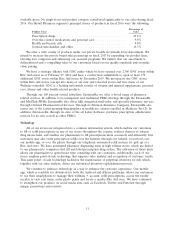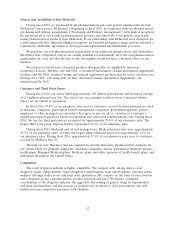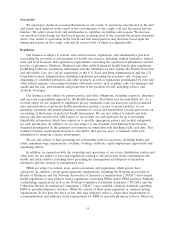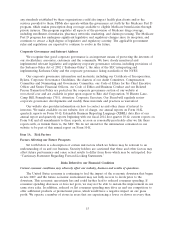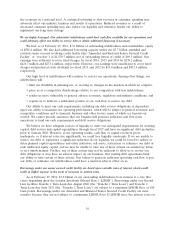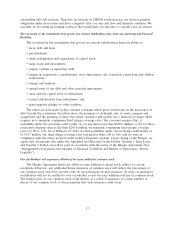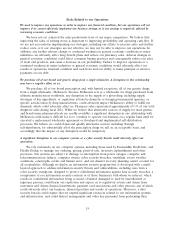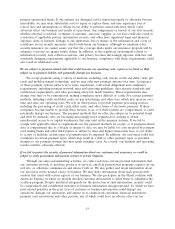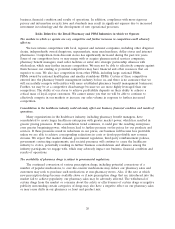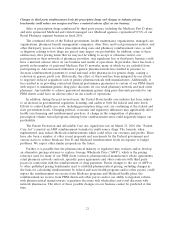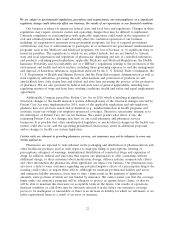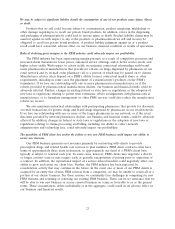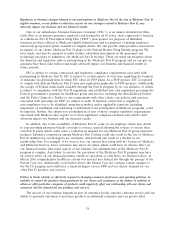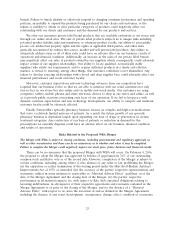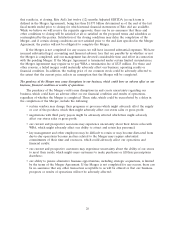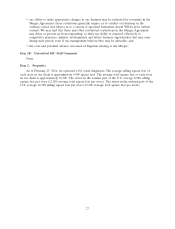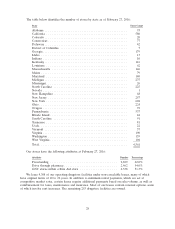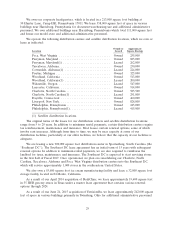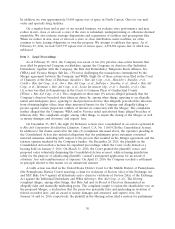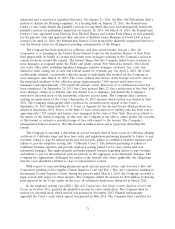Rite Aid 2016 Annual Report Download - page 21
Download and view the complete annual report
Please find page 21 of the 2016 Rite Aid annual report below. You can navigate through the pages in the report by either clicking on the pages listed below, or by using the keyword search tool below to find specific information within the annual report.Changes in third party reimbursement levels for prescription drugs and changes in industry pricing
benchmarks could reduce our margins and have a material adverse effect on our business.
Sales of prescription drugs reimbursed by third party payors, including the Medicare Part D plans
and state sponsored Medicaid and related managed care Medicaid agencies, represented 97.8% of our
Retail Pharmacy segment business in fiscal 2016.
The continued efforts of the Federal government, health maintenance organizations, managed care
organizations, pharmacy benefit management companies, other State and local government entities, and
other third-party payors to reduce prescription drug costs and pharmacy reimbursement rates, as well
as litigation relating to how drugs are priced, may impact our profitability. In addition, some of these
entities may offer pricing terms that we may not be willing to accept or otherwise restrict our
participation in their networks of pharmacy providers. Any significant loss of third-party business could
have a material adverse effect on our business and results of operations. In particular, there has been a
growth in the number of preferred Medicare Part D networks, many of which we are excluded from
participating in. Also increased utilization of generic pharmaceuticals has resulted in pressure to
decrease reimbursement payments to retail and mail order pharmacies for generic drugs, causing a
reduction in generic profit rate. Historically, the effect of this trend has been mitigated by our efforts
to negotiate reduced acquisition costs of generic pharmaceuticals with manufacturers. Additionally, it
has resulted in us providing contractual financial performance guarantees to certain of our PBM clients
with respect to minimum generic drug price discounts for our retail pharmacy network and mail order
pharmacy. Any inability to achieve guaranteed minimum generic drug price discounts provided to our
PBM clients could have an adverse effect on our results of operations.
In addition, during the past several years, the United States health care industry has been subject
to an increase in governmental regulation, licensing, and audits at both the federal and state levels.
Efforts to control health care costs, including prescription drug costs, are continuing at the federal and
state government levels. Changing political, economic and regulatory influences may significantly affect
health care financing and reimbursement practices. A change in the composition of pharmacy
prescription volume toward programs offering lower reimbursement rates could negatively impact our
profitability.
The Patient Protection and Affordable Care Act, signed into law on March 23, 2010 (the ‘‘Patient
Care Act’’) enacted an AMP reimbursement formula for multi-source drugs. The formula, when
implemented, may reduce Medicaid reimbursements which could affect our revenues and profits. There
have also been a number of other recent proposals and enactments by the Federal government and
various states to reduce Medicare Part D and Medicaid reimbursement levels in response to budget
problems. We expect other similar proposals in the future.
Further, it is possible that the pharmaceutical industry or regulators may evaluate and/or develop
an alternative pricing reference to replace Average Wholesale Price (‘‘AWP’’), which is the pricing
reference used for many of our PBM client contracts, pharmaceutical manufacturer rebate agreements,
retail pharmacy network contracts, specialty payor agreements and other contracts with third party
payors in connection with the reimbursement of drug payments. Future changes to the use of AWP or
to other published pricing benchmarks used to establish pharmaceutical pricing, including changes in
the basis for calculating reimbursement by federal and state health programs and/or other payors, could
impact the reimbursement we receive from Medicare programs and Medicaid health plans, the
reimbursement we receive from PBM clients and other payors and/or our ability to negotiate rebates
with pharmaceutical manufacturers, acquisition discounts with wholesalers and retail discounts with
network pharmacies. The effect of these possible changes on our business cannot be predicted at this
time.
21


